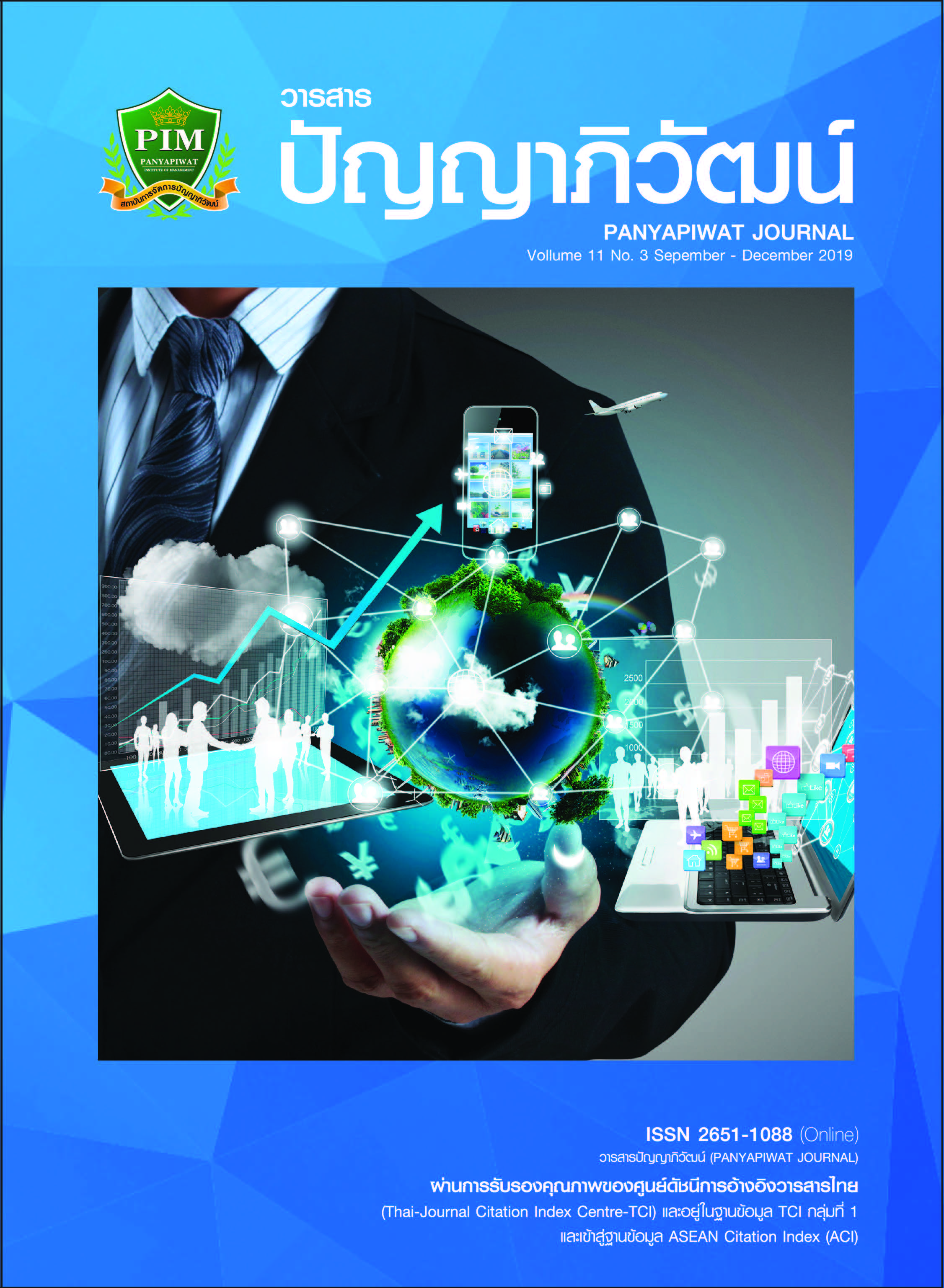THE APPROACH FOR INNOVATIONS TO VALUE ADDED TO THE FRUIT EXPORT BUSINESS FREEZE DRIED MANGO
Main Article Content
Abstract
The purposes of this research are as follows: (1) to study factors of supply chain and logistics management, freeze-dried process, marketing mix, and Innovation process; (2) to study the influences of the above factors; and (3) to propose innovative approaches to create value added for the export business of freeze-dried processed mango fruits. The research sample consisted of randomly selected 400 entrepreneurs and employees in the freeze dried processed mango fruit business in Suphan Buri and Ratchaburi provinces in Western Thailand. The purposively selected key research informants totaling 10 persons are divided into two groups, namely, group 1 consisting of entrepreneurs of processed fruits industrial factories, and group 2 consisting of the academic and experts on freeze dried processed agricultural industry. The instrument used was a semi-structured interview form. Statistics employed for data analysis were the mean, standard deviation, validity verification of causal relationship model, and analysis of the influence with latent variables.
The research results show that: (1) the supply chain management and logistics consist of 4 factors: partners in the chain, information technology using software, lean logistics, and lean manufacturing; the freeze dried process consists of 5 factors: the method and steps of work process, technologies, tools and equipment, production time, temperature and pressure, and system control; marketing mix consists of 4 factors: products, price, place of sale, and marketing promotion; the innovation process consists of 3 factors: upstream, midstream, and downstream; and the value added innovation for the business consists of 4 factors: resources, machines or production process, enhancement of customer perception, and cost reduction by increasing quality and adding product features; (2) regarding the influence of the factors, it is found that the innovation process and value-added innovation for the business receive the maximum total influences from marketing mix variables; and (3) six approaches for creating innovations to create value added to the business are identified: (1) the study of the system, its roles and problems or conflicts in the supply chain; (2) the creation of collaboration among members within the supply chain; (3) the integration of the business process; (4) the creation of production standards; (5) the expansion of marketing channel; and (6) the training to equip knowledge to concerned personnel.
Article Details
I and co-author(s) certify that articles of this proposal had not yet been published and is not in the process of publication in journals or other published sources. I and co-author accept the rules of the manuscript consideration. Both agree that the editors have the right to consider and make recommendations to the appropriate source. With this rights offering articles that have been published to Panyapiwat Institute of Management. If there is a claim of copyright infringement on the part of the text or graphics that appear in the article. I and co-author(s) agree on sole responsibility.
References
Apiprusyasakul, K. (2013). Logistics Information System Management. Bangkok: Focus Media and Publishing. [in Thai]
Chaimunkong, C. (2013). Strategies and supply Zen for global market competition (7th ed.). Nonthaburi: Duangkamonsamai. [in Thai]
Drucker, P. (2002). Managing in the Next Society. London: McGraw-Hill.
Gibbons, A. (2011). Innovation and the Developing System of Knowledge Production. Retrieved January 2, 2018, from https://folksonomy.co/?permalink=2424
Kittiyopas, D., Klumpasut, T. & Na Ayuthaya, N. L. (2012). Study of supply chain and logistic mangoes export in the central and northern regions. Agricultural Science Journal, 43(3Special), 363-367. [in Thai]
Kongsompong, K., Green, R. & Patterson, P. (2009). Collectivism and social influence in the buying decision: A four-country of inter and intra-national differences. Australasian Marketing Journal, 17(4), 142-149.
Kotler, P. & Armstrong, G. (2004). Principle of Marketing (10th ed.). New Jersey: Pearson Prentice-Hall.
Laundy, P. (2012). An Innovation Discipline Model. Retrieved January 2, 2018, from https://www.bpminstitute.org/resources/articles/innovation-discipline-model
Lummus, R. R. & Vokurka, R. J. (1999). Defining supply chain management: a historical perspective and practical guidelines. Industrial Management & Data systems, 99(1), 11-17.
McKeown, M. (2014). The Innovation. London: Prentice Hall.
Muenklang, J. (2012). Knowledge of innovation. Retrieved October 20, 2017, from https://jittrapawongsamai1.blogspot.com/ [in Thai]
Office of Agricultural Economics. (2009). Production and Marketing of Jasmine Rice. Bangkok: Ministry of Agriculture and Cooperatives. [in Thai]
Panpanich, N. (2012). The quantitative relationship between the implementation of McKinsey’s 7S strategy and the sustainability of the competitive advantage of small and medium enterprises in the biotech industry in Thailand. Journal of the Higher Education Association of Thailand, 18(2), 70-79. [in Thai]
Prachachatonline. (2015). Thai mango in the future, the export of lightning “Oland” indicates the link to grow a strong network. Retrieved October 20, 2017, from https://www.mfa.go.th/business/th/news/84/56144.html [in Thai]
Prince of Songkla University. (2017). freezer drying. Retrieved January 2, 2018, from https://www.tistr-foodprocess.net [in Thai]
Research and development of post harvesting and processing of agricultural products. (2007).Preserving fruit and vegetables. Retrieved October 20, 2017, from https://www.doa.go.th/pprdo/index.php?option=com_jotloader&view=categories&cid=1_31ab589a331d54b4140b358be14ff31f&Itemid=13 [in Thai]
SakulSurakapong (2016). Value added products and services in social enterprises. Journal WMS Journal of Management, 5(3), 46-56. [in Thai]
Samerjai, C. & Vareevanich, T. (2013). Marketing Principles. Bangkok: SE-EDucation. [in Thai]
Schilling, M. A. (2008). Strategic management of technological innovation (2nd ed.). NY: McGraw Hill Education.
Tipphachartyothin, P. (2014). Quality Control: The importance of consistency. Journal of Productivity world, 19(110), 91-96. [in Thai]
Vanichbancha, K. (2009). Statistics for research (4th ed.). Bangkok: Chulalongkorn University Book Center. [in Thai]
Vanichchinchai, A. & Igel, B. (2009). Total Quality Management and Supply Chain Management: Similarities and Differences. The TQM Journal, 21(3), 249-260.
Wallace, J. C., Butts, M. M., Johnson, P. D., Stevens, F. G. & Smiths, M. B. (2016). A multilevel model of employee innovation: Understanding the effects of regulatory focus, thriving, and employee involvement climate. Journal of Management, 42(4), 982-1004.


